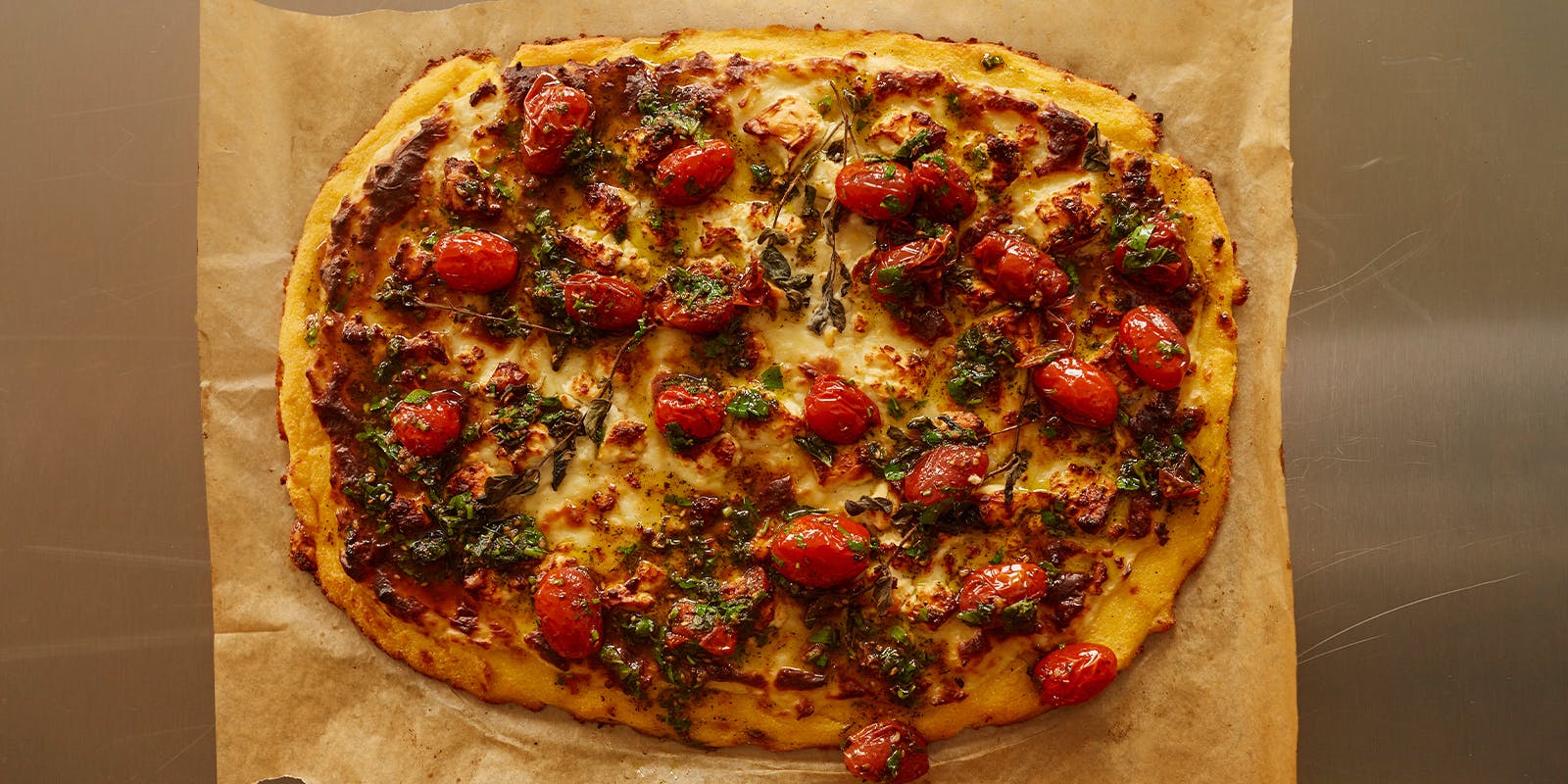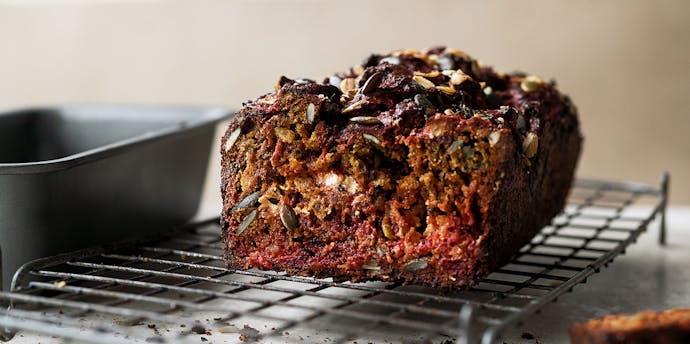Known in the Ottolenghi Test Kitchen as: 'polenta-pizza', 'polizza' or 'polenta not-a-pizza', this happy looking pie with its polenta base pairs perfectly with anything leafy and green.
It’s not a pizza, insisted Noor, when referring to this baked polenta, which does in fact look like a giant pizza. It ended up with multiple names at the Test Kitchen such as: ‘polenta-pizza’, ‘polizza’ or ‘polenta not-a-pizza’. It really is a happy-looking pie, with its yellows and reds and wonderfully golden edges. Serve with the chicory salad (p. 84) or anything leafy and green. You can keep this gluten-free by swapping out the flour for gluten-free flour, if you like.
Serves: 4-6
Prep time: 15 minutes
Cook time: 1 hour 30 minutes
- 80g unsalted butter
- 50g plain flour
- 750ml whole milk
- 4 garlic cloves, peeled and crushed
- 200g quick-cook polenta
- 65g pecorino romano,roughly grated
- 180g Greek feta, roughly crumbled
- 5g oregano sprigs (try to use the softer sprigs)
ZA’ATAR TOMATOES
- 400g datterini or cherrytomatoes
- 120ml olive oil
- 1½ tbsp balsamic vinegar
- 2 garlic cloves, peeled andcrushed
- 2 tbsp za’atar
- ½ tsp caster sugar
- 5g parsley, roughly chopped
- 5g oregano leaves, roughly chopped
1. Preheat the oven to 150°C fan.
2. Make the za'atar tomatoes. Put the tomatoes, oil, vinegar, garlic, ½ teaspoon of salt and a good grind of pepper into a medium baking dish, roughly30cm x 20cm. Cover tightly with foil and bake for 40–45 minutes, stirring halfway through, or until the tomatoes have just burst but aren't completely falling apart. Remove the foil, gently stir in the za'atar and sugar and leave to cool completely. Once cool, stir in the herbs (gently, so as not to break up the tomatoes).
3. Turn the heat up to 230°C fan. Line a large baking tray roughly 40cm x 30cm in size with baking parchment.
4. Put 40g of the butter into a medium saucepan over a medium-high heat. Once melted, add the flour and cook, whisking continuously, for 30 seconds until it smells like popcorn. Slowly pour in 350ml of the milk, whisking continuously to avoid any lumps, then add the garlic,½ teaspoon of salt and plenty of pepper, turn the heat down to medium and cook for 5 minutes, stirring often, until quite thick and longer floury-tasting. Set aside and cover with a piece of baking parchment, to stop a skin forming.
5. Meanwhile, prepare the polenta by first putting the remaining 400ml of milk, 300ml of water, 20g of the butter, 1¼ teaspoons of salt and a good grind of pepper into a medium sauté pan (or saucepan) over a medium-high heat. Once it gently bubbles, turn heat down to medium-low, slowly add the polenta, whisking continuously to incorporate, and cook for 2 minutes, to thicken. Add the pecorino and the remaining 20g of butter and stir with a spatula until incorporated. Quickly transfer to your prepared baking tray and spread out in a large oblong shape about 1cm thick and 38cm in length. Spoon over the béchamel and spread it it covers the surface, leaving a 1½cm rim exposed around the edges. Top evenly with the feta and the oregano sprigs and bake for 22 minutes, or until golden and bubbling on top and starting to brown around the edges. Leave to cool for 5–10 minutes.
6. Spoon about half the za’atar tomatoes on top of the baked polenta, serving the rest in a bowl alongside. Use a pizza cutter to easily cut into slabs and serve warm.
Za’atar tomatoes
- Keep in a sealed container in the fridge for up to a week.
- Try spooning these on to bruschetta, using them as a sauce for pasta or serving them alongside the caramelised fennel with orzo and saffron water (p. 200).













